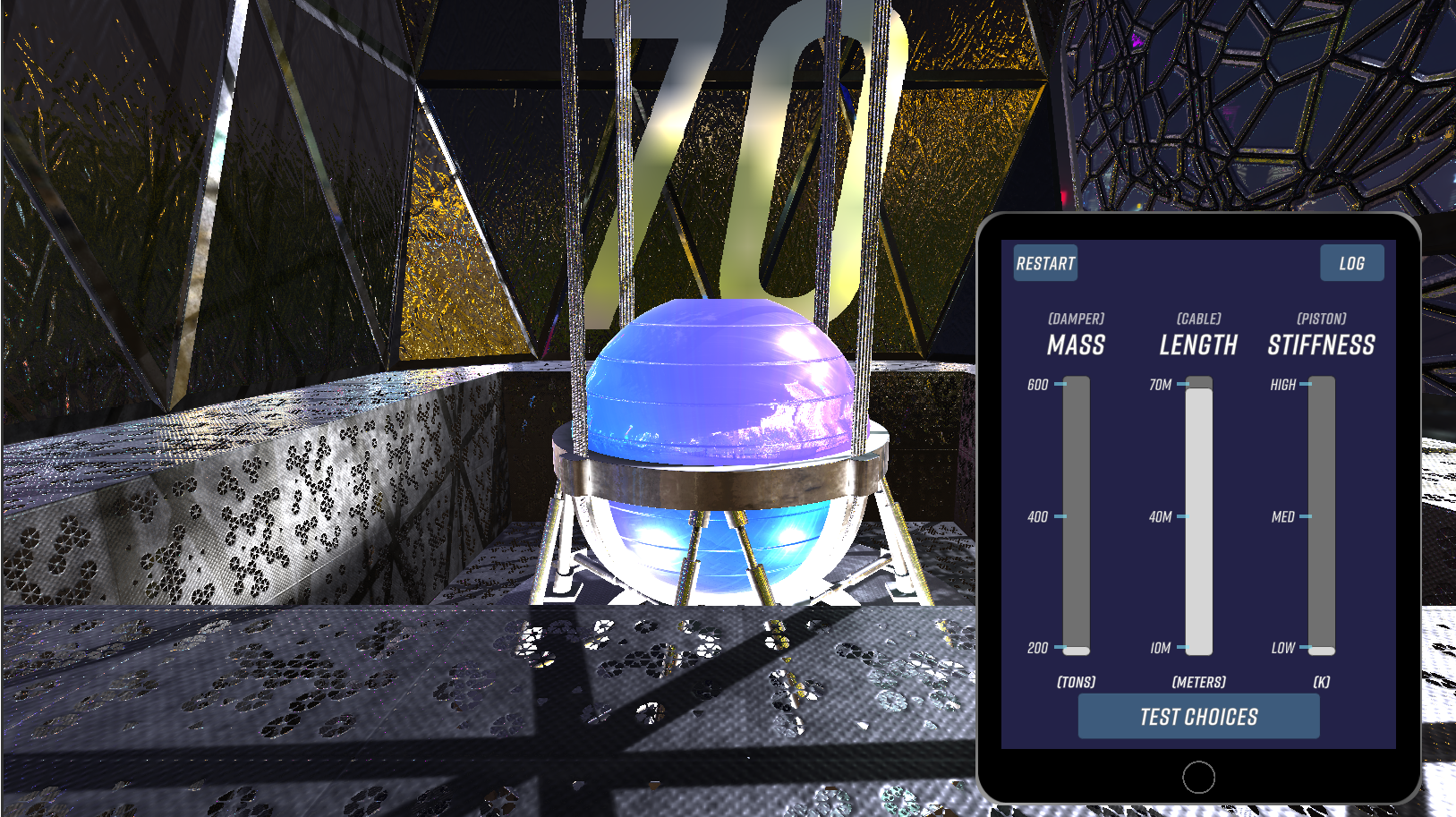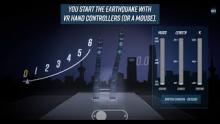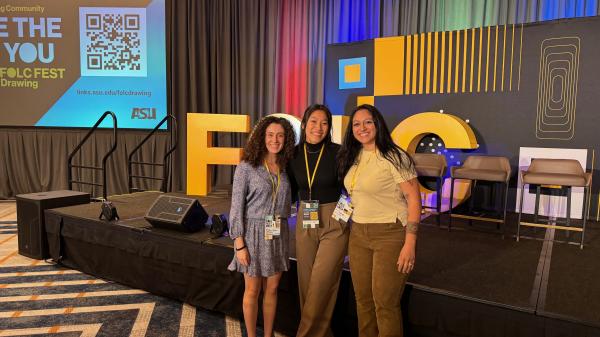
Embodied Games Lab (Johnson-Glenberg) - Cognitive Science Affiliate

Most Recent Project:
A NSF Cyberlearning Grant called Augmented Fluidity: MR Chemistry Titration with Haptics
Embodied Games Lab (Johnson-Glenberg)
The Embodied Games for Learning XR lab uses emerging technologies and sensors to affect cognitive and behavioral change. We design and create experiences along the eXtended Reality (XR) spectrum, starting with augmented to mixed to virtual reality(VR). We are specialized in assessing the efficacy of the content.
Several of our award-winning games and simulations can be found here embodied-games.com.
Current projects:
Dr. Johnson-Glenberg is on the leadership team of 4 current NSF grants:
An NSF AISL to called “WaterSIMmersive” – creating a mixed reality game for museums to help visitors understand complex Colorado River allocation issues, in conjunction with ASU CISA.
An NSF RETTL – creating a gamified mobile app using LiDAR to teach about physics and motion graphs using whole body movements, in conjunction with Physics Toolbox.
A NSF Cyberlearning Grant called Augmented Fluidity: MR Chemistry Titration with Haptics, in conjunction with Meteor Studio.
An NSF CAREER grant to create a mobile app called “Skeeter Breeder” using AI to help students understand how to eradicate mosquito breeding grounds around homes and school, in conjunction with Dr. Silvie Huijben at ASU
- Creating the "Save the Building Game", an interactive engineering instructional video game.
- Interactive COVID simulation available at new ASU XR website
- Assessing the efficacy of PC and VR-based games. This includes designing and running randomized control trials, as well as publishing results.
- Co-Director of the ASU Generative AI Executive Committee under the Learning Engineering Institute. Listen to recent interview on NPR.
- Design rubrics to assess the quality of education in VR modules.
- Launching and supporting "Catch a Mimic" multi-modal natural selection game for middle through high school-aged students. Available on the ASU XR website and through the Embodied Games Lab.
The Director, Dr. Johnson-Glenberg, has a history of entrepreneurship and she mentors students who have an interest in technology transfer. Her ASU spinout company website is embodied-games.com.
Several latest publications can be found here.
Platform is not Destiny - On how to design VR for education and avoid inserting passively viewed videos – a randomized control trial - https://onlinelibrary.wiley.com/doi/abs/10.1111/jcal.12567
One on how to use embodied gesture and hand controls in immersive VR can be found here: Immersive VR and Education: Embodied Design Principles That Include Gesture and Hand Controls – Frontiers in Robotics and AI
Always looking for motivated students!
Mina Johnson-Glenberg works in two arenas: academia and industry. After graduating with a doctorate in cognitive psychology, she went on to work as a research scientist at the University of Wisconsin-Madison. She moved to Arizona State University in 2009. She has been the principal investigator, or co-PI, on various private and public grants, including National Institutes of Health, National Science Foundation and the Gates Foundation. She was also an associate professor at Radboud University in Nijmegen, Netherlands from 2016-2017. Her current research focuses on STEM education, using games and mixed or virtual realities and XR.
Dr. Johnson-Glenberg is an entrepreneur who has started three companies. The first, called the NeuronFarm, was funded with multiple Small Business Innovative Research (SBIR) grants. Its flagship product was one of the first text comprehension training apps on the market using deep learning and AI for feedback. She then co-founded an ASU startup called SMALLab. Her current company, Embodied Games LLC, creates STEM content for lifelong learners using state-of-the-art augmented and virtual realities meshed with motion capture.
She also hosts the Future of Education in Virtual and Augmented Reality Meet-up at ASU. If you would like to participate click this link.
Current Lab Members
- Hardik Dharmeshkumar Maisuria
- Utkarsh Ankit
- Sophia Baia
- Chloe Reyes
- Micaela Leong
- Sri Swaminathan
- Abigail Camiso
- Jacob Stotts
Recent Past Lab Members
- Post Doc - Dr. Mehmet Kosa
- Augustin Bennett
- Christine Shin-Phing Yu
- Don Balanzat
- Shufan Yu
- Anoosh Kapadia
- Yueming "Alice" Bao
- Nia Cooper
- Aarushi Bharti
Vieyra, R. E., Megowan-Romanowicz, C., O'Brien, D. J., Vieyra, C., & Johnson-Glenberg, M. C. (2023). Harnessing the Digital Science Education Revolution: Smartphone Sensors as Teaching Tools. In J. Trumble, S. Asim, J. Ellis, & D. Slykhuis (Eds.), Theoretical and Practical Teaching Strategies for K-12 Science Education in the Digital Age (pp. 131-152). IGI Global. https://doi.org/10.4018/978-1-6684-5585-2.ch008
Johnson-Glenberg, M. C., Kosa, M. and O'Rourke H. P. (2022). STEM learning, science identity and immersivity: Giant screen films comparing 2D, 3D, and dome formats including a videogame assessment. Front. Educ. 7:1096889. 10.3389/feduc.2022.1096889
Johnson-Glenberg, M. C. (2022). Evaluating Embodied Immersive STEM VR: Quality of Education in Virtual Reality Rubric (QUIVRR). S. L. Macrine and J. Fugate (Eds.) Movement Matters: How Embodied Cognition Informs Teaching and Learning. Cambridge, MA: The MIT Press.
Ulrich, M., Evans, B., Liu, F. W., Johnson-Glenberg, M. C., & LiKamWa, R. (2021). AR-some Chemistry Models: Interactable 3D Molecules through Augmented Reality. MobileHCI '21 Adjunct: Adjunct Publication of the 23rd International Conference on Mobile Human-Computer Interaction. 20, 1-4. https://doi.org/10.1145/3447527.3474874
Johnson-Glenberg, M. C., Kosa, M., Balanzat, D., Nieland, R., Apostol, X., Rayan, J. A., Taylor, H., Bartolomea, H., & Kapadia, A. (2021) COVIDCampus Game: Making Safer Choices. Proceedings of the International Conference on Immersive Learning Network 2021 (ILRN).
Johnson-Glenberg, M. C., Bartolomea, H., & Kalina, E. (2021). Platform is not destiny: Embodied learning effects comparing 2D desktop to 3D virtual reality STEM experiences. Journal of Computer Assisted Learning. https://onlinelibrary.wiley.com/doi/10.1111/jcal.12567
DiBenigno, M., Kosa, M., & Johnson-Glenberg, M. C. (2021). Flow Immersive: A Multiuser, Multidimensional, Multiplatform Interactive Covid-19 Data Visualization Tool. Frontiers in Psychology, 12. https://www.frontiersin.org/articles/10.3389/fpsyg.2021.661613/full
Johnson-Glenberg, M. C., Jehn, M., Cheung, R., Nieland Zavala, R., Apostal, X., Rayan, J., & Bartolomea, H. (2021) Genesis of the Interactive CovidClassroom Simulation. Frontiers in Communication. https://www.frontiersin.org/articles/10.3389/fcomm.2021.657756/full
Ioannou, A. Bhagat, K. K., Johnson-Glenberg, M. C. (2021). Learning Experience Design: Embodiment, Gesture, and Interactivity in XR: Editorial. Educational Technology & Society.
Huang, W., Roscoe, R., Johnson-Glenberg, M. C., & Craig, S, (2020). Motivation, engagement, and performance across multiple virtual reality sessions and levels of immersion. Journal of Computer Assisted Learning, 37, 3 745-758. https://doi.org/10.1111/jcal.12520
Johnson-Glenberg, M.C., Su, M., Bartolomeo, H., Ly, V., Nieland Zavala, R., Kalina E. (2020). Embodied Agentic STEM Education: Effects of 3D VR Compared to 2D PC. Immersive Learning Research Network. Proceedings of 6th International Conference, iLRN 2020, Online, June 21-25, 2020. Immersive Learning Research Network. ISBN 978-1-7348995-0-4.
Ioannou, M., Georgiou, Y., Ioannou, A., & Johnson-Glenberg, M. C. (2019). On the understanding of students’ learning and perceptions of technology integration in low- and high-embodied group learning. In Lund, K., Niccolai, G. P., Lavoué, E., Hmelo-Silver, C., Gweon, G., and Baker, M. (Eds.). A Wide Lens: Combining Embodied, Enactive, Extended, and Embedded Learning in Collaborative Settings, 13th International Conference on Computer Supported Collaborative Learning (CSCL), V. 2. Lyon, France: International Society of the Learning Sciences.
Johnson-Glenberg, M. C. (2019). The Necessary Nine: Design Principles for Embodied VR and Active STEM Education (pp. 83-112). In P. Diaz, A. Ioannou, K.K. Bhagat, & J.M. Spector (Eds.), Learning in a Digital World: Perspective on Interactive Technologies for Formal and Informal Education. Singapore, Springer. https://link.springer.com/chapter/10.1007/978-981-13-8265-9_5
Johnson-Glenberg, M. C. (2018). Immersive VR and education: Embodied design principles that include gesture and hand controls. Frontiers in Robotics and AI, 5, 81. Open source https://doi.org/10.3389/frobt.2018.00081
M.C. Johnson-Glenberg, (2018). Immersive VR and education: Embodied design principles that include gesture and hand controls. Frontiers in Robotics and AI, 5, 81. Open source https://doi.org/10.3389/frobt.2018.00081
Poppelaars, A., Scholten, H., Granic, I, Veling, H., Johnson-Glenberg, M.C., & Luijten, M. (2018). When winning is losing: A randomized controlled trial testing a video game to train food-specific inhibitory control. Appetite, 129, 143-154. https://doi.org/10.1016/j.appet.2018.06.039. (http://www.sciencedirect.com/science/article/pii/S0195666317317592)
Hermans, R.C. J, van den Broek, N., Nederkoorn, C., Otten, R., Ruiter, E.L.M., & Johnson-Glenberg, M. C. (2018). Feed the Alien! The effects of a nutrition instruction game on children’s nutritional knowledge and food intake. Games for Health Journal, 7, 3, 164-174.
Johnson-Glenberg, M. C. (2017). Embodied education in mixed and mediated realities: Principles for content design. Chapter in D. Liu, C. Dede, and R. Richards (Eds.), Virtual, Augmented, and Mixed Realities in Education. Series: New Frontiers of Educational Research, Springer, Verlag. ISBN 978-981-10-5490-7.
Johnson-Glenberg, M. C., & Megowan-Romanowicz, C. (2017). Embodied science and mixed reality: How gesture and motion capture affect physics education. Cognitive Research: Practices and Implications. 2, 24. 10.1186/s41235-017-0060-9. https://cognitiveresearchjournal.springeropen.com/articles/10.1186/s41235-017-0060-9
Badilla, M.G., Johnson-Glenberg, M. C., Galindo, J., Revuelta, F., & Pedrera, I. (2017, June). Promoting nutrition with videogames as a support of science education curriculum. International Workshop on Gamification and Games for Learning. Gamilearn 2017, Tenerife, Spain.
Johnson-Glenberg, M. C. Birchfield, D., Megowan-Romanowicz, C. & Savio-Ramos, C. (2016). Effects of embodied learning and digital platform on the retention of physics content: Centripetal force. Frontiers in Psychology. http://dx.doi.org/10.3389/fpsyg.2016.01819 OpenSource.
Johnson-Glenberg, M. C., Birchfield, D., Megowan-Romanowicz, C., & Snow, E. L. (2015). If the gear fits, spin it! Embodied education and in-game assessments. International Journal of Gaming and Computer-based Simulations. 7, 4.
Johnson-Glenberg, M.C., Savio-Ramos, C., & Henry, H. (2014). “Alien Health”: A Nutrition Instruction Exergame using the Kinect Sensor. Games for Health Journal. Open Access. http://online.liebertpub.com/doi/pdfplus/10.1089/g4h.2013.0094
Johnson-Glenberg, M. C., Savio-Ramos, C., Perkins, K.K., Moore, E.B., Robb Lindgren, R., Clark, D., Brady, C., Sengupta, P., Martinez-Garza, M., Killingsworth, S., Adams, D., Gaydos, M., Barany, A., & Squire, K. (2014). Science Sims and Games: Best Design Practices and Fave Flops. Proceedings from the International Conference of the Learning Sciences (ICLS): Learning and becoming in practice, Boulder, CO. 3, 1201-1202. June 2014.
Johnson-Glenberg, M. C. (2014). Embodied Cognition for Education. In Denis, P. (Ed.) Encyclopedia of Educational Theory and Philosophy. Sage Publications.
Johnson-Glenberg, M. C., Birchfield, D. A., Tolentino, L., & Koziupa, T. (2013).Collaborative Embodied Learning in Mixed Reality Motion-Capture Environments: Two Science Studies. Journal of Educational Psychology. 106, 1, 86-104. doi: 10.1037/a0034008
Lindgren, R. & Johnson-Glenberg, M. C. (2013). Emboldened by Embodiment: Six Precepts regarding the Future of Embodied Learning and Mixed Reality Technologies. Educational Researcher. 42, 8, 445- 452. doi: 10.3102/0013189X13511661
Johnson-Glenberg. M. C., & Hekler, E. (2013). Alien health game: An embodied, exergame to instruct in nutrition and MyPlate. Games for Health Journal: Research, Development, and Clinical Applications, 2, 6, 354-361. http://online.liebertpub.com/doi/full/10.1089/g4h.2013.0057. doi: 10.1089/g4h.2013.0057.
Johnson-Glenberg, M. C., & the EGL Lab Group. (2013). Using motion sensing for learning: A serious nutrition game. In R. Shumaker (Ed.): Human Computers and Interactions International VAMR/HCII 2013, Part II, LNCS 8022, 380–389. Springer-Verlag Berlin Heidelberg.
Johnson-Glenberg, M.C. (2012). What is Learning in a Mixed Reality Environment and What Does an “Embodied Lesson” mean. November, 2012. ARIELSig, Special Augmented Reality Group at AERA. Supernews.
Cohen, T., Portiz, P., Kahol, K., MacKenzie, J. Olson, C., Johnson-Glenberg, M., & Patel, V. (2012). Avatar–Based Simulation in the Evaluation of Diagnosis & Management of Mental Health. Disorders in Primary Care. Journal of Biomedical Informatics. doi: 10.1016/j.jbi.2012.07.009
Abrahamson, D., Black, J. B., DeLiema, D. J., Enyedy, N., Hoyer, D., Fadjo, C. L., Gutiérrez, J. F., Martin, H. T., Petrick, C. J., Steen, F. F., Trninic, D. Johnson-Glenberg, M. C. (2012). In D. Abrahamson (Chair & Organizer). You’re it! Body, action, and object in STEM learning. Proceedings of the International Conference of the Learning Sciences: Future of Learning (ICLS) (Vol. 1, pp. 283-290). Sydney: University of Sydney / ISLS.
Johnson-Glenberg, M. C., Birchfield, D., Koziupa, T., Savio-Ramos, C. & Cruse , J. (July, 2012). Seeing It versus Doing It: Lessons from Mixed Reality STEM Education. Proceedings of the International Conference for the Learning Sciences (ICLS), 2, Sydney, Australia.
Johnson Glenberg, M.,C. & Cruse, J. (June, 2012). Serious Games in Technology-enabled Embodied Learning Environments: Two Games for Health with the Kinect. Proceedings from Games Learning and Society (GLS). Madison, WI.
Johnson-Glenberg, M. C. & the EGL Group (Embodied Games for Learning). (April, 2012). Learning in the K-12 Classroom: a Taxonomy. Symposium and Proceedings from the Annual Conference of the American Education Research Association (AERA), Vancouver, British Columbia.
Johnson-Glenberg, M. C., Koziupa, T., Birchfield, D. & Li, K., (2011). Games for Learning in Embodied Mixed-Reality Environments: Principles and Results. Proceedings for Games, Learning, and Society Conference, Madison, WI.
Johnson-Glenberg, M. C., Birchfield, D., Savvides, P., & Megowan-Romanowicz, C. (2011). Semi-virtual Embodied Learning – Real World STEM Assessment. In L. Annetta & S. Bronack (eds.) Serious Educational Game Assessment: Practical Methods and Models for Educational Games, Simulations and Virtual Worlds. pp. 241-258. Rotterdam: Sense Publications.
Birchfield, D., & Johnson-Glenberg, M. C. (2010). A next gen Interface for embodied learning: SMALLab and the geological layer cake. International Journal of Gaming and Computer-mediated Simulation, 2, 1, 49-58.
Johnson-Glenberg, M. C. (2010). Embedded Formative e-Assessment: Who Benefits, Who Falters? Educational Media International, 47, 2, 153-171.
Birchfield, D., Campana, E., Hatton, S., Johnson-Glenberg, M., Kelliher, A., Olson, L., Martinez, C. Savvides, P. & Tolentino, L. (2009). Embodied and mediated learning in SMALLab: A student-centered mixed-reality environment. ACM SIGGRAPH Emerging Technologies, SIGGRAPH.
Johnson-Glenberg, M. C., Birchfield, D., & Uysal, S. (2009). SMALLab: Virtual Geology Studies using Embodied Learning with Motion, Sound, and Graphics. Educational Media International, 46, 4, 267-280.
Johnson-Glenberg, M. C., Birchfield, D., Megowan-Romanowicz, C., Tolentino, L., & Martinez, C. (2009). Embodied Games, Next Gen Interfaces, and Assessment of High School Physics. International Journal of Learning and Media,1, 2. Access at http://ijlm.net/node/12813
Tolentino, L., Birchfield, D., Megowan-Romanowicz, C., Johnson-Glenberg, M. C., Kelliher, A., & Martinez, C. (2009). Teaching and learning in the mixed-reality science classroom. Journal of Science Education and Technology. 18, 6, 501-517. doi: 10.1007/s10956-009-9166
Buckley, S., & Johnson-Glenberg, M. C. (2008). Increasing literacy learning for individuals with Down syndrome and fragile X syndrome. In S.F. Warren & M.E. Fey (Series Eds.) & J.E. Roberts, R.S. Chapman, & S.F. Warren (Vol. Eds.), Communication and language intervention series: Speech and language development and intervention in Down syndrome and fragile X syndrome (pp. 233-254). Baltimore: Paul H. Brookes Publishing Co.
Johnson-Glenberg, M. C. (2007b). Web-based Reading Comprehension Instruction: Three studies of 3D-Readers. In D. McNamara (ed.) Reading Comprehension Strategies: Theory, Interventions, and Technologies. Mahwah, New Jersey: Lawrence Erlbaum Publishers.
Johnson-Glenberg, M. C. (2005). Web-based training of metacognitive strategies for text comprehension: Focus on poor comprehenders. Reading and Writing: An Interdisciplinary Journal. 18:1 - 33, 755-786.
Johnson-Glenberg, M. C., & Chapman, R. S. (2004). Predictors of parent-child linguistic tuning and label requests during play: A comparison between children who are typically developing and individuals with Down syndrome. Journal of Intellectual Disabilities Research, 48, 3, 225-238.
Johnson-Glenberg, M. C. (2000). Training reading comprehension in adequate decoders/poor comprehenders: Verbal vs. visual strategies. Journal of Educational Psychology, 92, 4, 772-782.
Johnson-Glenberg lab presents at American Education Research Association (AERA) conference in San Diego this week.
Members of the Embodied Games lab (https://psychology.asu.edu/research/labs/embodied-games-lab) presented at the session called Technologies for Situated, Grounded, Embodied Learning: The Unique Role of Extended Reality Experiences. https://tinyurl.com/yxrrj4dw
The talk was presented by Dr. Mina Johnson-Glenberg and the interactive poster was presented by Christine Shin-Phing Yu (Cognitive Science) and Shufan Yu (a visiting scholar from Central China Normal University). Two Oculus Quest 2 headsets were used to immerse attendees in the interactive educational game on civil engineering and Tuned Mass Dampers. Presenters at the session have been invited to write articles for a special edition on Extended Realities, which include Augmented Reality (AR), Mixed Reality (MR), and Virtual Reality (VR). Co-authors include Don Balanzat (SESE) and Anoosh Kapadia (Computer Science, ASU). The poster can be found at https://tinyurl.com/3z5way6y. Along with the VR educational game, the team presented preliminary results on an MR experiment using chemistry titration. This NSF-funded project was made in collaboration with AME’s Meteor Studio (https://meteor.ame.asu.edu/). The titration study includes a 3D-printed burette that serves as the hapticly manipulable interface in a 2 x 2 experiment comparing low embodied versus high embodied interface inputs; it assesses how those affect learning and content recall.
Watch: New Lab Video on Recent Projects
Professor Creates Game to Model How COVID Spreads
ASU psychology researcher creates game to promote understanding of how COVID-19 spreads
https://education.asu.edu/news/professor-creates-game-help-students-learn-how-covid-19-spreads



